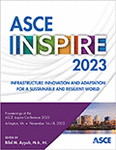Auto-Design-Based Optimizations of Prestressed Frames Using an Artificial Neural Network (ANN)-Based Hong-Lagrange Algorithm
Publication: ASCE Inspire 2023
ABSTRACT
Structural designs using artificial neural networks (ANNs) are relatively new even though the ANN has been an evolutionary technology in many areas, such as automotive, financial, and medical areas. The ANN-based Hong-Lagrange algorithm shows prospects for real-world applications, providing an auto design and optimizations that substantially increase design effectiveness while considerably reducing human efforts. Holistic designs of prestressed multi-story frames are performed in this study. Big datasets following American standards were generated based on the ABBA (auto-design-based building applications) frame generator, which was developed and verified by commercial software (ADAPT builder and MIDAS). ANNs are trained on big datasets, mapping 38 input parameters to 111 output parameters, to derive weight and bias matrices for the formulation of ANN-based objective and constraint functions of piperack frames. Costs, CO2 emissions, weights, and energy consumption are minimized by applying sequential quadratic programming (SQP) to ANN-based Lagrange functions constrained by equalities and inequalities, which are imposed by architectural and code requirements. The present study provides an application based on ANN technologies for structural designs, which not only enhances the design efficiencies but also the sustainability of building construction by reducing CO2 emissions and energy consumption.
Get full access to this article
View all available purchase options and get full access to this chapter.
REFERENCES
Wright, J., and Farmani, R. (2001). the Simultaneous Optimization of Building Fabric Construction, Hvac System Size, and the Plant Control Strategy. 7th IBPSA Conference, January 2014, 865–872.
Coley, D. A., and Schukat, S. (2002). Low-energy design: Combining computer-based optimisation and human judgement. Building and Environment, 37(12), 1241–1247. https://doi.org/10.1016/S0360-1323(01)00106-8.
Yi, Y. K., and Malkawi, A. M. (2009). Optimizing building form for energy performance based on hierarchical geometry relation. Automation in Construction, 18(6), 825–833. https://doi.org/10.1016/j.autcon.2009.03.006.
Peippo, K., Lund, P. D., and Vartiainen, E. (1999). Multivariate optimization of design trade-offs for solar low energy buildings. Energy and Buildings, 29(2), 189–205. https://doi.org/10.1016/s0378-7788(98)00055-3.
Zou, X. K., Chan, C. M., Li, G., and Wang, Q. (2007). Multiobjective Optimization for Performance-Based Design of Reinforced Concrete Frames. Journal of Structural Engineering, 133(10), 1462–1474. https://doi.org/10.1061/(asce)0733-9445(2007)133:10(1462).
Paya-Zaforteza, I., Yepes, V., Hospitaler, A., and González-Vidosa, F. (2009). CO2-optimization of reinforced concrete frames by simulated annealing. Engineering Structures, 31(7), 1501–1508. https://doi.org/10.1016/j.engstruct.2009.02.034.
Camp, C. V., and Huq, F. (2013). CO2 and cost optimization of reinforced concrete frames using a big bang-big crunch algorithm. Engineering Structures, 48, 363–372. https://doi.org/10.1016/j.engstruct.2012.09.004.
Hong, W.-K. (2019). Hybrid Composite Precast Systems: Numerical Investigation to Construction (1st edition, Elsevier).
Hong, W.-K., and Nguyen, D. H. (2023). Pareto frontier for steel-reinforced concrete beam developed based on ANN-based Hong-Lagrange algorithm. Journal of Asian Architecture and Building Engineering. https://doi.org/10.1080/13467581.2023.2193621.
Hong, W.-K., Le, T. A., Nguyen, M. C., and Pham, T. D. (2023). ANN-based Lagrange optimization for RC circular columns having multiobjective functions. Journal of Asian Architecture and Building Engineering, 22(2), 961–976. https://doi.org/10.1080/13467581.2022.2064864.
Hong, W.-K., and Le, T. A. (2023). ANN-based optimized design of doubly reinforced rectangular concrete beams based on multi-objective functions. Journal of Asian Architecture and Building Engineering, 22(2), 1413–1429. https://doi.org/10.1080/13467581.2022.2085720.
Martha, L. F., Rangel, R. L., Lopes, P. C., and Horta, C. (2022). LESM. Pontifical Catholic University of Rio de Janeiro.
MathWorks. (2022a). Deep Learning Toolbox: User’s Guide (R2022a). Retrieved July 26, 20122 from: https://www.mathworks.com/help/pdf_doc/deeplearning/nnet_ug.pdf.
MathWorks. (2022a). Parallel Computing Toolbox: Documentation (R2022a). Retrieved July 26, 2022 from: https://uk.mathworks.com/help/parallel-computing/.
MathWorks. (2022a). Statistics and Machine Learning Toolbox: Documentation (R2022a). Retrieved July 26, 2022 from: https://uk.mathworks.com/help/stats/.
MathWorks. (2022a). MATLAB (R2022a).
MathWorks. (2022a). Global Optimization: User’s Guide (R2022a). Retrieved July 26, 20122 from: https://www.mathworks.com/help/pdf_doc/gads/gads.pdf.
MathWorks. (2022a). Optimization Toolbox: Documentation (R2022a). Retrieved July 26, 2022 from: https://uk.mathworks.com/help/optim/.
Hong, W.-K. (2023a). Artificial Neural Network-based Optimized Design of Reinforced Concrete Structures. Tayor & Francis Group (1st edition, CRC press).
Hong, W.-K. (2023b). Artificial Neural Network-based Designs of Prestressed Concrete and Composite Structures (1st edition, CRC press, in printing).
Villarrubia, G., De Paz, J. F., Chamoso, P., and De la Prieta, F. (2018). Artificial Neural Networks Used in Optimization Problems. Neurocomputing 272: 10–16. doi: https://doi.org/10.1016/j.neucom.2017.04.075.
Calculation sheet of Karbala Refinery Project. GS E&C, Seoul, Korea.
Hong, W.-K. (2023c). Artificial Intelligence-Based Design of Reinforced Concrete Structures: Artificial Neural Networks for Engineering Applications (1st edition, Elsevier).
ACI. Building Code Requirements for Structural Concrete (ACI 318-19) Commentary on, & Building Code Requirements for Structural Concrete (ACI 318R-19). (2019). An ACI Standard. ACI Committee 318.
Loads, M. D., and Structures, O. (2017). Minimum design loads and associated criteria for buildings and other structures. In Minimum Design Loads and Associated Criteria for Buildings and Other Structures. https://doi.org/10.1061/9780784414248.
Information & Authors
Information
Published In
History
Published online: Nov 14, 2023
ASCE Technical Topics:
- Algorithms
- Artificial intelligence and machine learning
- Building design
- Business management
- Computer programming
- Computing in civil engineering
- Design (by type)
- Engineering fundamentals
- Frames
- Materials engineering
- Materials processing
- Mathematics
- Neural networks
- Parameters (statistics)
- Practice and Profession
- Prestressing
- Statistics
- Structural design
- Structural engineering
- Structural members
- Structural systems
- Sustainable development
Authors
Metrics & Citations
Metrics
Citations
Download citation
If you have the appropriate software installed, you can download article citation data to the citation manager of your choice. Simply select your manager software from the list below and click Download.
